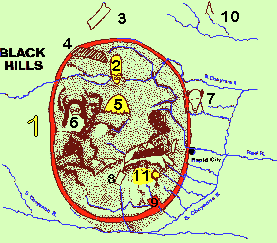Jump to Page Navigation Buttons--
Star Map of Black Hills Ceremonies |
|---|


Jump to Page Navigation Buttons--
Star Map of Black Hills Ceremonies |
|---|
Animal constellation (1,2,3,4,5 plus bright Aldebaran in the head/neck) in a conventional night sky pic. We face north and as on all starmaps, the left side is east (face north and hold a star map above your head to see why). In November, Orion's Belt rises (and remains) south of the southerly ecliptic. You'll have to pan this big pic. Download (sav as local file) and print skypic -- use laser printer, not ink jet.
. Numbers on the Star Map refer to stars and constellations. The red track -- Ki Inyanka Ochanku, the Sacred Hoop -- is traced by certain bright stars: the Pleiades (7 sisters), Rigel, Sirius, Castor-Pollux, Auriga B, Capella. Numbers on the Star Map refer to stars and constellations. The red track -- Ki Inyanka Ochanku, the Sacred Hoop -- is traced by certain bright stars: the Pleiades (7 sisters), Rigel, Sirius, Castor-Pollux, Auriga B, Capella. | |||
|---|---|---|---|
| No. | Name | Astron. name | Represents |
| 0 | ---- | Aldebaran | First magnitude star lying in the bright Hyades cluster (Taurus) on backbone line to Pleiades (Animal's head) |
| 1 | Tayamnipa | Pleiades | Head of constellation "Animal" (perhaps Buffalo)--Harney Peak. Also known as Winchincala Sakowin (7 little girls) |
| 2 | Tayamnituchuhu | Betelgeuse | With Rigel, Animal's ribs |
| 3 | Tayamnichankahu | Orion's Belt | Animal's backbone |
| 4 | Tayamnituchuhu | Rigel | Animal's other rib, Hoop marker |
| 5 | Tayamnisinte | Sirius | Animal's tail, Hoop marker; Animal's name means "born of 3 relatives" |
| 6 | ---- | Procyon | A Hoop marker |
| 7 | Matotipila marker | Castor ("Twins") | Constellation is Bear's Tipi, aka Devil's Tower |
| 8 | Matotipila marker | Pollux ("Twins") | Mato Tipila and Hoop marker |
| 9 | Mato Tipila constellation | 8 of the 12 stars in Gemini | Constellation is Bear Tipi, now Grey Buffalo Horn (aka Devil's Tower), place of solstice Sun Dance |
| 10 | ---- | Beta Aurigae | Hoop marker |
| 11 | ---- | Capella | Hoop north marker |
| 12 | Part of Chanshasha Ipusye | Triangulum | Part of Dried Willow constellation, Spring Equinox, Pipe ceremony |
| 13 | Part of Chanshasha Ipusye | Aries | Dried Willow, People are in the winter camps, Pipe Ceremony begins round of spring ceremonies |
| 14 | Chanshasha Ipusye | ---- | Standing for Pipe (red willow used in smoking); spring renewal ceremonies in Black Hills |
 --Sun and Star Constellations and Time--explains how sun is "in" a constellation, and how the age of these ceremonies can be known from that. --Sun and Star Constellations and Time--explains how sun is "in" a constellation, and how the age of these ceremonies can be known from that.
"What is in the stars is on earth and what is on earth is in the stars." This idea unites the ceremonial map in the circle of stars, not only with sites in the Black Hills, but with a round of ceremonial actions at sacred sites there, ending with a Sun Dance at the Bear's Lodge (Devil's Tower) June 21 (summer solstice). "As above, so below" that is, what occurs in the stars is mirrored on earth is a very old idea now forgotten by Western culture. It is expressed in Alchemy and the even older idea that humankind and our events are a microcosmic mirror of the macrocosm. The Lakota elders believed this, and some of that knowledge did survive. Below is a sacred map of the Black Hills within the sacred hoop, the earth-mother ceremonial home that mirrors the circle of stars in the skies. Actions of the people, not just places, are the sky-mirror -- the ceremonial round performed by the people or their representatives. "As the sun moved counterclockwise through the constellations of the ecliptic, the Lakota moved clockwise through the Black Hills from one ceremonial site to another; each site correlated to a constellation. The ceremonies mirrored the sun's path on the plains. After the Sun Dance and National Councils (held at Bear Butte) the 3-month ritual of incorporating the powers of the Wakan Washte (the ideal Good Life) was completed. The people were on the Red Road. Their will, individually and collectively, was now attuned to Wakan Tanka." |
|---|
Sacred Hoop, Chan Gleshka Wakan, red clay valley which circles the Black Hills, site of a race whose tumult lifted the hills higher and formed the valley. Stars mirror Spring ceremonies. |  |
|---|
 Numbers on the Black Hills Map refer to sacred sites. The red track -- Ki Inyanka Ochanku, the Sacred Hoop -- was created by a race run by 2-legged and 4-legged. Numbers on the Black Hills Map refer to sacred sites. The red track -- Ki Inyanka Ochanku, the Sacred Hoop -- was created by a race run by 2-legged and 4-legged. | |||
|---|---|---|---|
| 1 | Ki Iyanka Ochanku | Race Track Valley | Race Track or Sacred Hoop bounding ceremonial area, mirrored in stars. |
| 2 | Mata Tipi Paha | Bear's Tipi, also Grey Buffalo Horn (Devil's Tower) | Site of June 21 Sun Dance that concludes Spring Sacred Ceremonial round. |
| 3 | Paha Zipela | Slim Buttes | ---- |
| 4 | Paha Sapa | Black Butte | ---- . |
| 5 | Pe Sla | Old Baldy | Center of Black Hills, Welcome back all life in peace (Okislataya Wowahwata -- Peace at a Bare Spot, 2nd stage of spring ceremonies |
| 6 | Hinhan Kaga Paha | Ghost (Owl) Butte | Spirits of dead start path on Milky Way. |
| 7 | Mato paha | Bear Butte | Sacred underground emergence origin; desecrated by park site |
| 8 | Mnikata | Hot springs | For sacred purifications, now desecrated by tourist operations. |
| 9 | Pte tali yapa | Buffalo Gap | Sacred entrance/exit to Hoop |
| 10 | Wakinyan Paha | Thunder Butte | Welcoming back thunders (Wakinyan) ceremony, when sun is in Pleiades, Yate Iwakicipi ceremony |
| 11 | ---- | Harney Peak | When the sun is in Pleiades, the sacred round starts from Harney Peak, or any of several buttes. |
|
MAP CORRELATIONS: If you jumped back & forth between Star and Hills maps and were puzzled, you're being too literal, looking for a mirror that's like a 1-to-1 matched diagram. Both the stars in the circle and the Black Hills contain time in their mirrors of each other, but not in the same way. People and their ceremonies are a part of the time-of-the-hills. The relative motions of the sun (and moon and certain planets) are time-in-the-stars. When the sun is "in" certain constellations, it is time for certain ceremonies to begin. Old Baldy, a bare place in the Hills marks the center of the ceremonial geography -- but there is no star or constellation to mark the starry circle's center in the sky, the correspondence is 2 different kinds of empty places. (Although in the 11th century, when the light from the Crab Nebula Supernova reached earth so the star was even visible in daytime, it occupied this empty center.) There's a red clay valley round the Black Hills (not so neat a circle as the elders drew above) but the Red Race Track in the star map is only indicated by certain bright stars, and is imagined. Constellations for any culture (all have them) aren't outlined by stars like so many connect-the-dots pix, they are imaginative projections on scatters of bright lights. The Lakota sky/earth mirroring is spiritual, metaphorical, symbolic, artistic -- not a literal mapping of 2 diagrams onto each other. HISTORICAL NOTE: Knowledge that is in part scientific was the most vunerable to loss during the long, genocidal conquest. It is usually subject to all the hostility directed against what the invarders consider a false religion they attempt to eradicate, because they won't recognize it as science. Too, the invaders were ignorant men, and their interpreters, usually sell-out half-breeds, even more so. They lacked the knowledge from their own civilization to understand and appreciate that of the Native peoples. Iindigenous peoples generally integrated their knowledge differently than WestCiv came to, so it was all considered "just some native superstitions" and actively attacked by the Christians. Naming a sacred spot "Devil's Tower" is all too common across the continent. In fact if you see such religiously pejorative names attached to any geological features, you can be pretty sure the site was sacred once to some indigeneous peoples. As can be seen from the Lakota book's re-vivification of Lakota star knowledge (which took many years of work by native scholars), attacks on Native religion were really attacks on entire lifeways, since religion wasn't something separate, all forms of knowledge were at risk, and all methods of preservation had to be clandestine. It didn't change when non-missionary anthros started showing up. In the 19th century (and well into the second half of the 20th), how many of them knew any science, anyway? If they were trusted to be told anything, how many of them could understand it? Much astronomical knowledge would never have been commonplaces, known to all; most of it would be known only by tribal s"experts" who had made long studies of the phenomena. Imagine some Blue Blob Thing anthros from the far stars dropping by. They collect some "data" from such earth-primitive savants as Einstein and Mandelbrot. Their interpeter is a 20-year-old couch potato who is a big Star Trek fan. What they're going to bring back to the Blue Blob Thing University is going to be mighty strange. In fact, Einstein's dead, so they get all the lowdown on relativity, certain evil gods called "nukes" and such from their braindamage case TV fan. I think the situation for Native knowledge is quite comparable to what they're teaching and writing, now, at the Blue Blob campus of U Sirius. CREDITS: Star and Black Hills maps scanned and colored from recommended Sinte Gleshka University book, Lakota Star Knowledge. Star quilt drawing by me, pattern created and popularized through Indian country by Lakota quiltmakers. Tabulated data is summarized from Star Knowledge book, and all quotes come from there. |
|---|

Custom Search
|
Seasons |
Menu |
MENU |
|---|
Page prepared by Paula Giese, copyright 1995, 1996
CREDITS: Aftr scanning, I had to redtraw the blurrily-printed constellations and Black Hills maps from Lakota Star Knowledge, then colored them for this website. The big "night sky photo of the Animal constellation" actually was generated by Astronomy simulation software called "Dance of the Planets" (for PC's only). Tabulatd data came from Lakota Star Knowledg but I'm responsible for assembling and tabulating it and correlating it with conventional astronomical names.
Last updated: Monday, July 08, 1996 - 7:29:52 PM